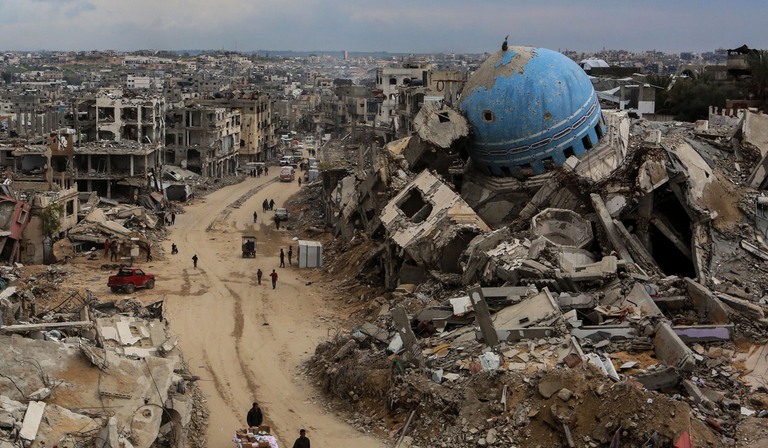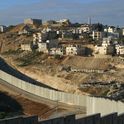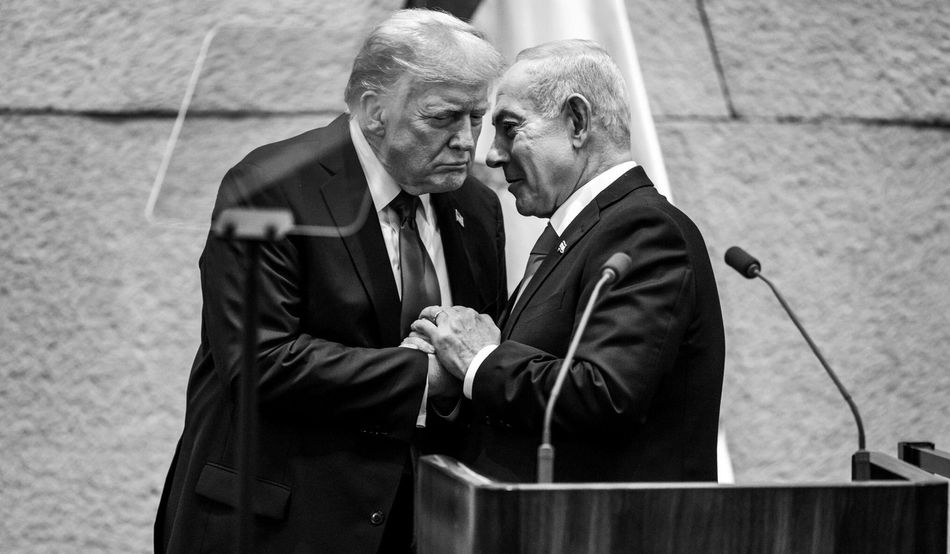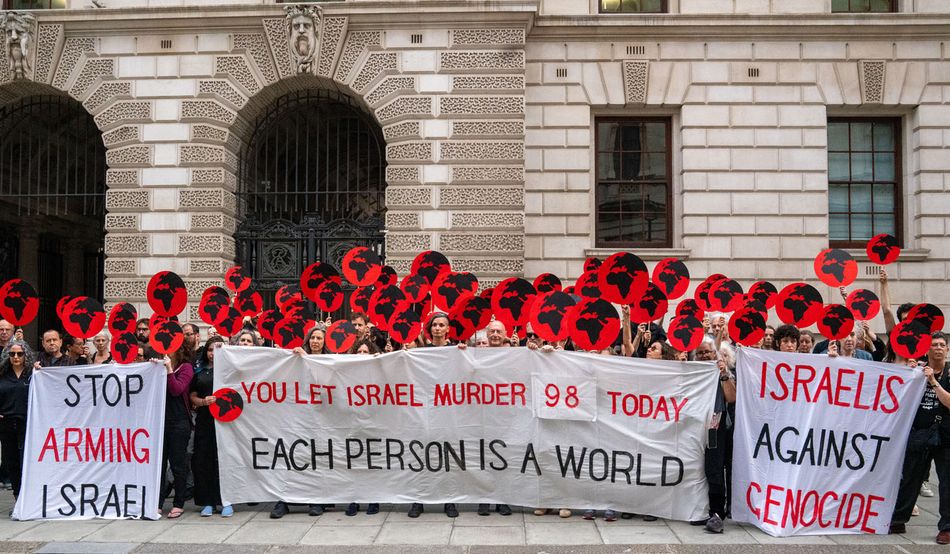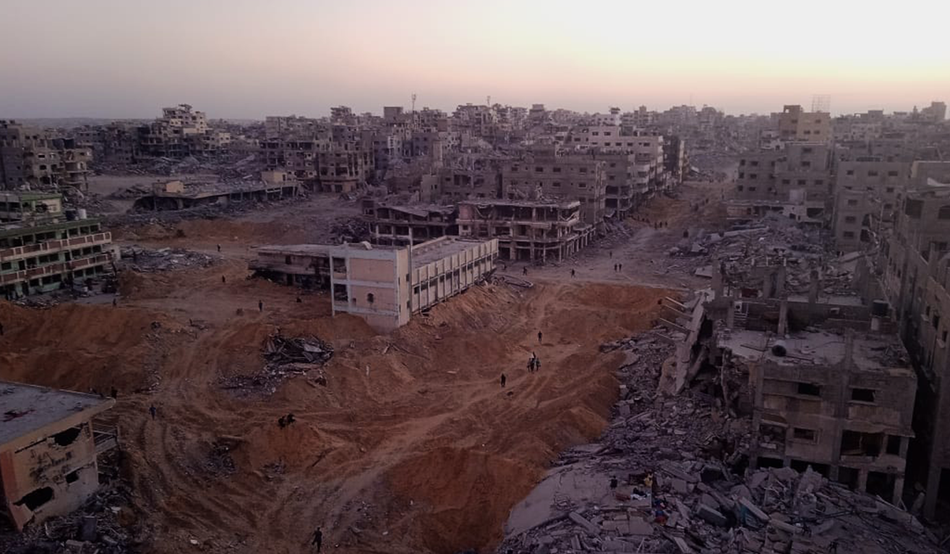Green is the colour Kareem remembers most. In Rafah, the southern Gaza city where he grew up, there were green fields, farms and countryside. He remembers it being very calm and everything from his school to the supermarket being close. There was a place called Tea Time Café, where he liked meeting with his friends. Green was everywhere too because of the Hamas flags. He recalls the Palestinian militant group, which took over the Strip by force in 2007, two years after Israel’s abrupt withdrawal from the territory after 38 years of military occupation, put them “everywhere”, regardless of whether people wanted it to or not.
But now much of the city, home to around 275,000 before the Gaza war began, is gone. “I can’t think of anybody from Rafah that still has his house. Everything is destroyed—all my schools that I have studied in,” says the 22-year-old, who left Gaza in 2022 and now lives in Paris.
The satellite images are stark. One from 15th October 2023 shows Rafah’s Tel al-Sultan neighbourhood of residential buildings criss-crossed with streets. By 23rd October 2025, the blocks look like little more than piles of dust. Another shows where an elementary school once stood, now an area flattened and cleared of rubble. It was the site of an aid distribution hub for the Gaza Humanitarian Foundation (GHF), the body set up with backing from Israel and the United States.
Other images show more of the same across the city: streets of grey-black rubble. “Effectively the proportion of structures that have been eradicated in Rafah… is higher than what was destroyed in Hiroshima and Nagasaki,” Israel’s Haaretz newspaper estimated in June.
“Why are you just interested in Rafah?”, asked a woman living in Gaza City, when I interviewed her some months ago. Yes, Rafah and Khan Younis (another city in the south) have “no life or people, but the Gaza Strip has many cities”, she said. “I have no word to describe the situation in Gaza City. There is nothing. There is no life here.”
Before the bloodshed began in October 2023, most of Gaza’s population of more than two million lived in four cities—Gaza City in the north, Deir al-Balah in the centre and Khan Younis and Rafah in the south—alongside a handful of smaller ones, such as Beit Hanoun and Beit Lahiya, also in the north. Rafah “was one of the most upscale cities in Gaza”, Yaqub, 43, a former teacher who grew up in Rafah, tells me via WhatsApp. “It was inhabited by kind, cooperative people, most of whom were good farmers. It had well-organised streets, good schools and hospitals. It was famous for a variety of high-quality agricultural crops.”
Two years later, the scale of the damage across the Strip is such that Donald Trump’s son-in-law Jared Kushner, who visited Gaza after a US-brokered ceasefire was agreed in October, said it looked “almost like a nuclear bomb had been set off”.
The war’s grim statistics will be familiar: according to official Palestinian figures, at least 67,938 Palestinians had been killed in Gaza by mid-October, most of whom are believed to be civilians, including nearly 20,000 children; and at least 169,000 wounded. The fatalities are thought likely to be undercounts, as many bodies are trapped under rubble. In terms of destruction, assessments vary, but the consensus is that it has been widespread and at a high rate. According to the UN Satellite Centre, 78 per cent of structures—192,812—in Gaza had been damaged or destroyed by August this year. Researchers at Oregon State University, based on analysis of open-access satellite radar data, estimate that, as of 2nd October 2025 60.2 per cent of buildings in Gaza—a total of 198,883—have been damaged or destroyed since the war began. A Haaretz report published in July cited analysis of satellite imagery by Adi Ben-Nun, a professor at Hebrew University, which found that at least 70 per cent of structures in Gaza had been damaged severely.
“Gaza’s destruction compares only to the most severely impacted cities in Ukraine,” Corey Scher, from Oregon’s Conflict Ecology Lab, tells me via email. “Because impacts from conflicts such as the Syrian Civil War still have not been comprehensively assessed, we have to go back to the Second World War. The extent of damage is greater than… in any single German city during that conflict and, on a percentage basis, there is more damage across Gaza than there was as a result of the US firebombing of Dresden.”
Gaza is divided into five governorates. Scher and his colleagues estimate that, by January 2024, the greatest rate of damage to buildings was in the North Gaza and Gaza governorates, where the cities of Beit Hanoun, Jabaliya, Beit Lahiya and Gaza City are located. Some 66 per cent of buildings were damaged or destroyed in North Gaza, and 68 per cent in the Gaza governorate. By June that year, the estimated damage had gone up to 69 and 74 per cent respectively.
In the southernmost governorates, Rafah and Khan Younis, the damage increased at a higher rate from January to June 2024, rising from 31 per cent and 9 per cent of buildings damaged in January to 51 and 33 per cent respectively. Oregon’s Conflict Ecology Lab estimates that by October 2025, at least 53 per cent of Rafah’s buildings were damaged. Ben-Nun’s analysis shows that by July this year as much as 89 per cent of Rafah’s buildings were at least partly destroyed. This would align with what Hamas reported in June, that the Israel Defense Forces (IDF) had razed to the ground a 12,000 square metre area of Rafah, and that 90 per cent of residential neighbourhoods there had been destroyed or damaged, alongside much of the sewage network, mosques, schools and water wells.
Forensic Architecture (FA), the research agency based at Goldsmiths, University of London, has mapped the Gaza war in a project called “A cartography of genocide”, incorporating a variety of sources, including video, photographs, written testimony, and satellite and remote-sensing imagery. (South Africa commissioned a report based on the mapping for its submission in the genocide case against Israel at the International Court of Justice.)
“Rafah doesn’t exist. East Khan Younis doesn’t exist. East Gaza [City] doesn’t exist,” says Eyal Weizman, FA’s director, when I ask what its research suggests is left of the Strip’s cities. “Then you go beyond the ‘yellow line’, where the [IDF’s] extended buffer zone [is], and you have a patchwork of buildings and rubble.” After the ceasefire came into force on 10th October, Palestinians returning to homes across Gaza were met with a similar sight: buildings burned out, damaged or levelled to the ground.
Throughout the war, the Israeli government has argued that the IDF only targets civilian infrastructure being used by Hamas, or because it has a military justification for doing so. But Israeli leaders were threatening widespread destruction and displacement of the local population from the start.
On the evening of 7th October 2023, in his first address to the nation after Hamas’s massacre in southern Israel, Benjamin Netanyahu vowed not only to “forcefully avenge this dark day”, but to raze the Strip. “All of the places which Hamas is deployed, hiding and operating in, that wicked city,” he said of Gaza, “we will turn them into rubble. I say to the residents of Gaza, ‘Leave now because we will operate forcefully everywhere.’” On 12th October, Israel’s Air Force posted on X that it had “dropped about 6,000 bombs against Hamas targets”, along with photos of razed buildings.
Similar statements were made by Israeli politicians, public figures and the wider public. “Flatten everything, just like Auschwitz is today,” the head of a council in northern Israel said in a radio interview in December 2023. According to FakeReporter, an Israeli monitoring group, on X from 7th October to mid-November 2023 there were around 18,000 mentions in Hebrew of appeals to flatten, erase or destroy Gaza (and from then to mid-October this year there were a further 68,000 mentions). There have been some calls, too, to lay waste to Gaza’s cities. One of Jerusalem’s deputy mayors, Aryeh King, did so repeatedly. “It’s been 18 days since the pogrom… that the Nazis carried out in the Gaza envelope,” he posted on Facebook on 24th October. “Benjamin Netanyahu Gaza, Khan Younis, Rafah and Beit Lahiya are still standing. Shame on you!”
The Lexicon of Brutality: Key Terms from the Gaza War (2025), a book co-authored by the Israeli historian Adam Raz, includes an entry for Beit Hanoun, the northernmost city in the Strip. According to a 2017 census, it had a population of 50,000. By the end of December 2023 the city, the site of early battles between the IDF and Hamas, was reportedly all but gone. That month, the commander of the IDF’s 2908 Battalion was filmed describing what the army had done to the city, citing the book of Genesis: “Battalion 2908 went into Beit Hanoun and did what Shimon and Levi did in the city of Nablus” (the Bible tells of how the brothers killed all the males in the town and proceeded to pillage it). “The mission is not over,” the commander continued. “We still have the whole of Gaza to do to it like [we did to] Beit Hanoun.”
In the early days of the war, some argued that such pronouncements were intended to weaken the enemy’s morale. Yet others saw them as expressing a genuine intent to exact vengeance for Hamas’s murders and hostage-taking, to go beyond the stated aims of the IDF operation (“total defeat” of Hamas and the release of the hostages). Whether the scale of the destruction of Gaza’s cities was a by-product of the war, or part of its design, is a question that “we will debate for the next 50 years”, Raz tells me over the phone. He predicts “there won’t be documents” to scrutinise.
An armoured bulldozer is driving into a grey, three-storey block, foregrounded by sand, stones and earth. The building looks burned out, war-damaged. The vehicle pushes against it, once, twice, more.
“Rabbi Zarbiv is flattening a house in Gaza in a live broadcast,” says the anonymous narrator of the clip. “He doesn’t leave a job half-done.” The shot switches to a close-up and the rabbi emerges from the bulldozer, smiling, hands in the air. “Until victory!” he calls, “am Israel chai [the people of Israel live]!”
The rabbi, rabbinical court judge Avraham Zarbiv, is a 53-year-old volunteer reservist in the IDF. He has become something of a meme—and a symbol in Israel of “the destruction of the Gaza Strip to the ground”, as Arutz Sheva, the religious Zionist Israeli media outlet, put it in an interview with him in July. His surname has even become slang, a verb meaning “to knock buildings down”—with heavy machinery. X is filled with clips of him doing just that.
In that interview, the rabbi explains that the bulldozers are no longer mere support for the army in Gaza; mowing down buildings is the fighting: “Instead of clearing buildings, bringing soldiers into them and endangering them, we destroy houses from the outside.”
The flattening of structures and clearing of land has been evident across Gaza, both in the IDF’s creation of military corridors dividing up the territory, and in the cities. Though occurring from late 2023, it has characterised the later stages of the war, and it is also the nexus where the various drivers of Israel’s onslaught meet: ostensible military objectives, a messianic ideology that wants Jewish settlement in the Strip, and the desire for revenge after 7th October.
When the war started, Beit Hanoun was one of the first targets for airstrikes. On 13th October 2023, more than a million Palestinians were ordered to evacuate and go south. The Israeli army launched its ground offensive on 28th October, entering northern Gaza.
Over the following months, the IDF expanded its buffer zone around Gaza’s perimeter from 300 metres wide to about a kilometre, and started building the Netzarim corridor, a three kilometre-wide military zone running from east to west to Gaza’s coast. The Israeli army was also striking south, however, and by the end of November, when 105 hostages were released during a week-long ceasefire, Rafah and Khan Younis had also suffered damage. On 5th December 2023, IDF tanks went into Khan Younis. By the end of January 2024, nearly half of Gaza’s buildings were damaged or destroyed, according to Oregon State figures.
Throughout the war, the IDF has ordered Palestinians to evacuate southwards as well as west, but in December 2023 strikes on the south and centre increased. By April 2024, most displaced Palestinians were living in Rafah. In May, when Israeli troops invaded the city, taking control of the buffer zone along the border with Egypt known as the Philadelphi corridor, displaced people were told to evacuate to al-Mawasi, the site of a “humanitarian zone” on the coast.
Forensic Architecture’s mapping shows that in October 2024 the Israeli army started to create another corridor, Mefalsim, splitting North Gaza from Gaza City and destroying residential buildings. In December 2024 Moshe “Bogie” Ya’alon, a former Israeli defence minister and IDF chief of staff, and a former member of Netanyahu’s right-wing Likud party, described the army’s activity in North Gaza as ethnic cleansing. “There’s no Beit Lahia. There’s no Beit Hanoun. They’re currently operating in Jabaliya, and essentially, they’re cleaning the area of Arabs,” he said. By May 2025, a similar process had taken place in Rafah, FA mapping shows, with the area evacuated and razed. The GHF hub was built on the city’s ruins.
Alongside professional contracting firms, smaller demolition teams have also been active across the Strip, which often include ideological settlers in their ranks
A ceasefire agreed in January 2025 ended in March when Israel launched airstrikes. Throughout that time, the army had remained in an expanded buffer zone around the Gaza border. In May this year, Israel launched Operation Gideon’s Chariots with the declared aims of destroying Hamas infrastructure and rescuing any remaining hostages, as well as taking control of more of the Strip. The army was also building another corridor, Magen Oz, around Khan Younis. In July this year, much of eastern Gaza City was razed, at which time the IDF said it controlled 65 per cent of Gaza. The following month it launched a second phase of the operation aimed at taking over Gaza City. Residents were again ordered to evacuate to an expanded “humanitarian zone”, though many stayed as the journey was dangerous and expensive and they could not afford to leave. By August, per Oregon State’s figures, at least 56 per cent of the Strip’s buildings were damaged or destroyed.
Forensic Architecture has identified “waves of destruction”, Eyal Weizman explains in a video call. First by airforce bombing, such as occurred most intensively in the first weeks of the war, and which has continued ever since. This left a “patchwork of destruction”, mostly in Gaza City and the north, though also in the south. The second wave happened when troops moved in from the end of October 2023. Here, “the military policy is to break into cities, usually not along existing routes, because they think they are mined or whatever and they don’t want to be predictable, so they carve pathways” through built-up areas, minimising risk. To protect soldiers, rubble is taken and piled up around the pathways “going into the heart of those cities”.
The third wave of destruction, he terms “ungrounding” (Weizman has a book of that name coming out next year). This is when heavy machinery, of the sort that Rabbi Zarbiv is so identified with, is used for “erasing any traces on the ground”, mostly from the extended Gaza perimeter zone inwards. He notes that buildings in Gaza tend to be taller nearer the sea, so those further east, nearer to the border fence, will be easier to bulldoze. The army has vehicles of the kind Zarbiv uses, but private contractors have been brought in to clear land and rubble, too (the army and defence ministry have reportedly paid heavy equipment owners 5,000 shekels, or more than £1,000, a day to come into Gaza). Alongside professional contracting firms, smaller demolition teams have also been active across the Strip, which often include ideological settlers in their ranks. “At the beginning of the war, each brigade had around 20 armoured bulldozers in working condition… Now, we don’t even have 10, and these don’t always have professional operators. Thus, every brigade commander, or even a battalion commander who wishes to make progress in this war, employs these forces,” one IDF source told Haaretz.
Ungrounding, which has chiefly happened beyond the “yellow line”, involves heavy machinery tearing “everything under the surface”, upturning it so “you have no distinction between where was the road, where was the sidewalk,” says Weizman, describing it as “desertification”. He compares this to what happened after the 1948 war that established the state of Israel, when traces of Palestinian towns and villages were removed and new towns built on top of them. In Gaza City, FA’s mapping shows how parts of the neighbourhood of Shuja’iyya, formerly home to some 100,000 people and the site of the city’s largest market, has been ungrounded. In Zaytun, near the Old City; in Rimal, the prosperous zone near the beach that was all but destroyed in October 2023; and in Tuffah, a quarter of the Old City, there is more of a “patchwork” of destruction.
Testimonies by soldiers serving in Gaza collected by Breaking the Silence (BtS), an Israeli organisation founded by former IDF soldiers, tell of how buildings and infrastructure have been destroyed. When we speak in early August, the group’s advocacy director Joel Carmel tells me BtS is receiving “lots of testimonies of destruction, because this stage of the war puts an emphasis on destruction”. Rather than actively engaging Hamas, “Mostly what soldiers are doing now is protecting themselves rather than capturing new areas. And destroying more and more the places they have already occupied.”
In April 2025, BtS published “The Perimeter”, testimonies from the buffer zone along the Gaza border. Together, they indicate systematic and deliberate destruction. One reservist who served near Khan Younis from December 2023 to January 2024 described taking over Khirbat Ikhzaa, an area across the border from Nirim and Nir Oz—kibbutzim devastated by Hamas on 7th October.
“After the conquest [stage], came the destruction-of-houses stage,” he told the organisation. “It wasn’t done simultaneously. First of all, there were the lines of advancement for the brigade and battalion offensives, and the clearing began only after that. There’s a map that the Gaza Division made of polygons along the Strip fence that are marked in green, yellow, orange, and red. Green means that more than 80 per cent of the buildings were taken down—residential buildings, greenhouses, sheds, factories, you name it—it needs to be flat. That’s the order. There are no structures, except for that UNRWA school and that small water facility—for everything else, the directive was ‘nothing left’.”
Soldiers told BtS that it was understood that Palestinians who had lived in this area “should have nothing to come back to”, says Carmel. This echoes statements by Israel’s leaders. Netanyahu told a Knesset committee in May that “we’re destroying more and more houses”, adding “the only result from this will be the desire of Gazans to emigrate outside the Strip. The main problem will be with the destination countries.”
In the field, there are commanders who follow the spirit of this direction. One such is Brigadier General Yehuda Vach, who leads the 252nd Division. Vach and his brother, Golan, are settlers from the West Bank. Vach has reportedly operated recklessly, endangering soldiers’ lives (claims the army has denied). Soldiers serving in Gaza have reported that under him Golan, a reservist with the rank of colonel, led a small unit dedicated to destroying buildings, and that civilians, some of whom looked like hilltop youth from the settlements, were also involved. Soldiers serving under Golan reported that they had daily targets for buildings to destroy, something echoed in the BtS testimonies.
Then there is the Uriah Force, a small demolition team operating in the Strip. In an interview with the ultra-Orthodox newspaper Makor Rishon, its commander “Uriah”, a sergeant major in the reserves who is a West Bank settler, confirmed that demolition is a characteristic of the war. “We had a two-day break recently to process,” says the commander, who appears masked in photographs accompanying the interview, “and for everyone the difficulty of dealing with destruction came up. We love to build. But when you look under a house and see a shaft filled with explosives, you understand that there is no choice, that we are saving lives every day.”
Soldiers testify that they have been told to burn down houses they have stayed in by pouring oil on curtains, books and mattresses
Other methods of destruction are described in testimonies BtS has received, such as arson, or filling an old, soon to be decommissioned armoured personnel carrier with explosives. Soldiers say they have been told to burn buildings they have stayed in by pouring oil on curtains, books and mattresses. Some testified that they have used olive oil from the houses they occupied or oil from army-issued cans of tuna.
Often, the stated reasons for the demolitions are military. For instance, destroying buildings that could be vantage points for Hamas (following this logic, once these are levelled, the neighbouring buildings become vantage points and also need to be razed). Or that areas such as the Gaza “perimeter” zone or the Netzarim corridor need to be kept clear to protect troops. All in all, the army has released the names of 921 soldiers killed since 7th October 2023, 471 of whom went into Gaza after the initial ground invasion. On 28th October this year, a reservist heavy machinery operator was killed in Rafah beyond the “yellow line”.
The stated logic of arson is to prevent Hamas getting intel on the soldiers. But “what is understood… by the soldiers who spoke to us,” says Carmel, “is that there won’t be anywhere to go back to. The house won’t be usable.” He adds: “And you can see in it a punishment.” The IDF has stated that it destroys buildings only with “a clear military need”, or if there is a risk to IDF forces, and that the army “has never had a policy that allows for the deliberate destruction of civilian property”.
“Domicide” is the word for the purposeful destruction of homes, and there is another for the deliberate destruction of cities: urbicide. The term, which, unlike genocide, has not been codified as a crime in international law, gained traction after the Bosnian conflict of 1992–95, in particular following the sieges of Mostar and Sarajevo.
Targeting cities ensures people have nowhere to return to. “It’s about clearing spaces of those you think are different. And it’s about consolidating your control of those spaces,” says Martin Coward, a professor at Queen Mary, University of London, and author of the 2009 book Urbicide: the Politics of Urban Destruction.
After the Allied bombing of Germany in the Second World War and the Battle of Stalingrad in 1942–43, widespread destruction of cities became a general characteristic of war. In the Soviet-Afghan war, from 1979 to 1989, Russia used a tactic of “rubblization”. In a recent paper, Coward argued that Russia’s war in Ukraine is intentionally “anti-urban”, with cities flattened across the frontline to punish the local population and curb attempts at resistance.
Gaza is a special case because it is such a concentrated area, meaning the damage has been great. And its people have not been able to leave.
In academia, “There is a debate about the relationship between deliberate destruction of cities and genocide,” says Coward. “I think they are distinct, but they go hand in hand.” (A government minister’s celebration of Gaza being “flattened” was cited by South Africa as evidence in its International Court of Justice case.)
Jalal, 35, grew up in Shuja’iyya, the Gaza City neighbourhood reduced to rubble in December 2023. In October, we meet in a café on Mill Road in Cambridge, where he has lived for three-and-a-half years. He arrives with a small tabby cat on his shoulder. His memories of life in Gaza City are a mix of joy and hardship.
In the public imagination, Gaza is caught in cycles of perpetual conflict. Since Hamas took over the Strip in 2007, there have been five Israel-Hamas wars and an 18-year blockade. “After the 2014 war,” the Palestinian writer Raja Shehadeh notes in his 2024 book What Does Israel Fear from Palestine?, “people were heard saying, ‘Life in Gaza has always been consumed by war. I never knew it to be otherwise.’ The new generation had forgotten that there was once a different life in the Strip.”
During that war, Shuja’iyya was under IDF bombardment and the site of battles. Jalal saw his cousin killed and was himself wounded. During this latest war, anxiously watching from afar as his relatives were displaced, Jalal has lost dozens of members of his extended family. Only the day before we met, a cousin had been killed.
Jalal grew up on a street where a lot of his family lived, sharing a room with his four brothers and sister. He remembers not having electricity for more than a few hours a day, that there was no work, and the sense of being caged, which ultimately led him to leave.
But there was happiness, too: when his brother got married in 2016, or when fasting for Ramadan. Or when he used to go to the sea. His cousin had a motorbike. They would take a tent and have a barbecue, or buy chips or coffee from a boy on the beach. They would often go on Saturdays, “enjoying the view, the fresh air”.
“It is a little-known fact that Gaza was once a happy place with a happy people who had a great sense of humour and led lives like other seafaring people,” Shehadeh writes. “But this was many decades ago.” Before the war of 1948—which Israelis call their war of independence and Palestinians call the Nakba or “catastrophe”—Gaza was not isolated from the land surrounding it. There was no border fence until the 1970s—since when it has been rebuilt and upgraded. During the First World War, when British and Ottoman forces fought over Gaza City, some Palestinian families fled to other parts of Palestine, including Jaffa, which became part of Israel after 1948. At that time, explains the historian Dotan Halevy, only 30 years after the First World War, 200,000 people fled to Gaza, as part of the 750,000 Palestinians who were dispossessed in the 1948 war.
Kareem, who grew up in Rafah, has not been back since he left in 2022. Now he won’t be able to. “It’s not like I don’t miss it,” he says, “but it’s like, when you miss someone, you feel like part of you is with that person. But if, God forbid, that person is dead, you feel like part of you is dead. It’s the same feeling.”
“You can say you miss your city if it still exists. It’s gone, you know.”
Some names in this article have been changed
